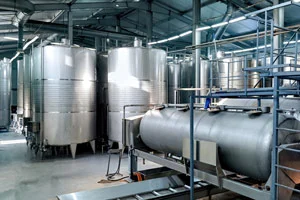Fermentation guarantee
The proper development of alcoholic fermentation is the first step in achieving quality wines. The need to meet the nutritional demands of the yeast will make it essential to create protocols that are adjusted to the grape’s particular situation, with the concentration of sugars to be fermented being the determining factor.
Nitrogen supply recommendations must be based on the proportion of the different types of nitrogen found in grapes, with the organic fraction being predominant (66-75%) over the inorganic (25-34%). On the other hand, it is also necessary to consider the yeast’s absorption capacity of each type and the influence that both will have on the aromatic profile of the final wine, with the amino acid nitrogen enhancing both fermentative and varietal aromas. The amino acid imbalance caused by exposing grapes to high temperatures must also be taken into account, which is why organic nutrition is especially important in grapes affected by climate change.
The supply of organic nitrogen in the early stages of alcoholic fermentation allows the yeast to assimilate it better, knowing that this will be greatly reduced at alcoholic strengths above 5%.
Autolysed yeasts are the organic nitrogen resource used to correct nutritional deficiencies in musts and to enrich organic nitrogen. Their use displaces the ammonium salts (sulfate and phosphate) so commonly used in the winery to correct nitrogen content, which, when applied systematically and at the wrong time, produces results contrary to those expected, since it depletes the nutritional resources of the musts, leading to kinetic and sensory problems.
When ammonium and organic nutrients are added simultaneously, the yeast consumes the ammonium directly, causing excessive cell multiplication and premature yeast exhaustion, thus causing fermentation problems and reduction odors. The exclusive use of organic nutrients (amino acids) at the beginning of fermentation avoids excess cell multiplication, lower hydrogen sulfide production, greater aromatic intensity and increased varietal character.

Actimax Natura
Nutriente orgánico, procedente de levadura 100% autolisada, para fermentación alcohólica. Constituye una fuente muy rica en nitrógeno orgánico, una dosis de 30g/hl aporta 44 mg/l de NFA y 40mg/l de NOPA. Proporciona un aporte equilibrado de aminoácidos y vitaminas en la fase inicial de fermentación, reduciendo la aparición de problemas en su fase final y optimiza la calidad organoléptica de los vinos.
This alcoholic fermentation nutrient is the result of research carried out within the CENIT DEMETER Project (2008-2011) Strategies and viticultural and oenological methods in the face of climate change. Application of new technologies that improve the efficiency of the resulting processes, within the specific lines of work carried out with the Rovira i Virgili University and the Spanish National Research Council (CSIC).
Biomass production as a special case
The production of biomass by wineries is a particular case that is becoming more and more frequent. The multiplication of yeasts involves exerting an overpressure on micro-organisms that must develop a significant number of generations, more than is necessary when we are talking about traditional seeding. The multiplication process will therefore lead to a decrease in resistance to fermentation conditions in those cases where the yeast is not supplemented to cover this overexertion.
When working with yeast multipliers, specific nutritional work is required to combine the need for nitrogen to permit rapid multiplication, the supply of growth co-factors to facilitate high population and survival factors to provide resistance and easy adaptation to fermentation conditions.
Antimicrobial protection of the multiplication process is an essential step. The use of chitosan during multiplication, which is very effective on non-Saccharomyces yeasts and lactic acid bacteria, will provide higher purity inoculates, resulting in a higher yeast population and a lower risk of deviations during fermentation.
NFA
Combination of amino acid nitrogen (fundamental unit of enzymes and proteins) and easily assimilated mineral to accelerate the process.
Growth cofactors
Minerals present in yeast autolysates (gears of cellular metabolism) and thiamine (essential coenzyme for cell multiplication)
Survival factors
Fatty acids and sterols (ergosterol) present in yeast autolysates, which strengthen the fluid mosaic and its relationship with the environment.
Microbiological control
The addition of chitosan provides strict microbiological control, maximising the multiplication rate and preventing the development of contaminating flora.

Industry 4.0 in alcoholic fermentation
The guarantee of quality in wines depends on the proper control of fermentation. The large number of tanks used simultaneously during the harvest makes it impossible to monitor them all effectively. However, the emergence of Industry 4.0 in oenology aims to facilitate the work of technicians by allowing multi-parameter control of the different tanks, even automating certain parameters depending on the type of winemaking process, the time of fermentation or the desired objective. Tank Control makes it possible to see the state of fermentation from different points of view:
- Temperature: Monitoring and control of the fermentation temperature with automatic opening and closing of the cooling systems, which can be adjusted to different density ranges.
- Density: Monitoring of the on-line density, checking the proper evolution of the fermentation kinetics and permitting the automation of the temperature ranges, as well as the frequency of pumping-over, according to the evolution of the fermentation.
- Pumping over: Efficient and effective breaking of the cap through the injection of compressed air. The automation of the process makes it possible to adjust the pumping-over frequencies and times to the type of production and density range.
- ORP: Control of the state of oxidation and reduction of wines, reducing the risk of the appearance of reductions and the effect of oxygen on the wine to be treated when used in combination with the DOSIOX system.

